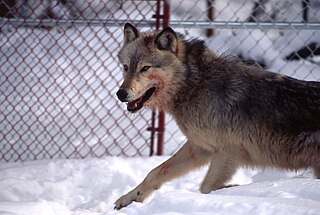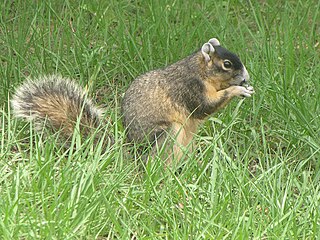
Brisbane Water National Park is a national park on the Central Coast of New South Wales, Australia. The national park is situated 70 kilometres (43 mi) north of Sydney and 12 kilometres (7.5 mi) southwest of Gosford. It consists the Brisbane Water and Mooney Mooney Creek waterways.

The western gray squirrel is a tree squirrel found along the western coast of the United States and Mexico. In some places, this species has also been known as the silver-gray squirrel, the California gray squirrel, the Oregon gray squirrel, the Columbian gray squirrel and the banner-tail. There are three geographical subspecies: Sciurus griseus griseus ; S. g. nigripes ; and S. g. anthonyi.

The Endangered Species Act of 1973 is the primary law in the United States for protecting and conserving imperiled species. Designed to protect critically imperiled species from extinction as a "consequence of economic growth and development untempered by adequate concern and conservation", the ESA was signed into law by President Richard Nixon on December 28, 1973. The Supreme Court of the United States described it as "the most comprehensive legislation for the preservation of endangered species enacted by any nation". The purposes of the ESA are two-fold: to prevent extinction and to recover species to the point where the law's protections are not needed. It therefore "protect[s] species and the ecosystems upon which they depend" through different mechanisms. For example, section 4 requires the agencies overseeing the Act to designate imperiled species as threatened or endangered. Section 9 prohibits unlawful 'take,' of such species, which means to "harass, harm, hunt..." Section 7 directs federal agencies to use their authorities to help conserve listed species. The Act also serves as the enacting legislation to carry out the provisions outlined in The Convention on International Trade in Endangered Species of Wild Fauna and Flora (CITES).

The red squirrel, also called Eurasian red squirrel, is a species of tree squirrel in the genus Sciurus. It is an arboreal and primarily herbivorous rodent and common throughout Eurasia.

The northern Idaho ground squirrel is a species of the largest genus of ground squirrels. This species and the Southern Idaho ground squirrel were previously considered conspecific, together called the Idaho ground squirrel.

The fox squirrel, also known as the eastern fox squirrel or Bryant's fox squirrel, is the largest species of tree squirrel native to North America. It is sometimes mistaken for the American red squirrel or eastern gray squirrel in areas where the species co-exist, though they differ in size and coloration.

Black squirrels are a melanistic subgroup of squirrels with black coloration on their fur. The phenomenon occurs with several species of squirrels, although it is most frequent with the eastern gray squirrel and the fox squirrel. Black morphs of the eastern gray and fox squirrels are the result of a variant pigment gene. Several theories have surfaced as to why the black morph occurs, with some suggesting that the black morph is a selective advantage for squirrels inhabiting the northern ranges of the species, with the black fur providing a thermal advantage over its non-melanistic counterpart.
The Maryland darter is a species of freshwater ray-finned fish, a darter from the subfamily Etheostomatinae, part of the family Percidae, which also contains the perches, ruffes and pikeperches. It is considered one of the rarest freshwater fish species in the world, due in part to its incredibly limited geographic range and difficulty of detection. The last sighting of one was in 1988. The Maryland darter is named after the only state in which it is known to occur. The species was long known only by two specimens until being "re-discovered" in 1962. From 1965 into the 1980s, the species was believed to have been confined to a single riffle in Deer Creek. Possible explanations for the decline of the species center around widespread habitat degradation and reduction in water quality resulting from increasing rates of urbanization within the watershed. While the IUCN has declared the species extinct, the United States Fish and Wildlife Service has not, and keeps it on the Endangered Species List.

Wolf reintroduction involves the reintroduction of a portion of grey wolves in areas where native wolves have been extirpated. More than 30 subspecies of Canis lupus have been recognized, and grey wolves, as colloquially understood, comprise nondomestic/feral subspecies. Reintroduction is only considered where large tracts of suitable wilderness still exist and where certain prey species are abundant enough to support a predetermined wolf population.

The Hawaiian hoary bat, also known as ʻōpeʻapeʻa, is a species of bat endemic to the islands of Hawaiʻi. The Hawaiian hoary bat occupies the major Hawaiian islands, making it the only extant and native terrestrial mammal in the islands. Some studies report that the mainland hoary bat lives in sympatry on the Hawaiian Islands alongside the Hawaiian hoary bat, although this is disputed. The Hawaiian hoary bat was officially named the state land mammal of Hawaiʻi in 2015. It is a federally listed endangered taxon of the United States.

The Shenandoah salamander is a small, terrestrial salamander found exclusively in Shenandoah National Park in Virginia. The Shenandoah salamander inhabits a very small range of land on just three mountain peaks. Due to the small habitat range, interspecies competition, and climate change, the population of the Shenandoah salamander is vulnerable to extinction. Mitigating human effects on the habitat of the species will be essential in attempting to preserve and grow the population.

John L. Koprowski is a Dean and Professor, Haub School of Environment & Natural Resources, University of Wyoming, mammalogist, conservation biologist, and leading expert on the ecology and conservation of wildlife, especially squirrels.
Vagn F. Flyger was a Danish-American wildlife biologist and one of the world's foremost authorities on squirrels. His landmark work was The 1968 Squirrel "Migration" In The Eastern United States. Flyger was also one of the first wildlife biologists to utilize tranquilizer guns in the 1950s when they were first introduced. In the 1960s, he experimented with dart guns in the Arctic on seals, whales and polar bears. However, seeking a field of study that kept him closer to home, Flyger focused most of his remaining research on squirrels.
An out-of-danger species is an animal or plant species formerly categorized as Rare, Vulnerable, or Endangered that has since been removed from these lists because the species' survival has been relatively secured, e.g. Ginkgo biloba. Often known as a delisted species, these animals have been moved out of the Rare, Vulnerable, or Endangered categories through conservation efforts and government policymaking to ensure their survival and population growth. The International Union for Conservation of Nature (IUCN) established its list of endangered species in 1964, subsequently becoming a global authority on wildlife conservation. The following year, the United States created the U.S. Fish and Wildlife Service to act as a federal authority on endangered species. Currently, both international and domestic organizations implement recovery efforts and track species' population growth, delisting when necessary. Removing a species from the endangered species list is generally a slow process; most organizations and governments require long periods of observation both before and after delisting. There have been numerous efforts to delist endangered species, with both international and country-wide recovery plans being regularly implemented. These programs have led to the recovery of dozens of species, but their overall effectiveness remains contested.

Sherman's fox squirrel is a subspecies of the fox squirrel. It lives in the U.S. states of Florida and Georgia in fire-prone areas of longleaf pine and wiregrass, especially around sandhills. A tree squirrel, Sherman's fox squirrel has lost much of its habitat to farming and development. This type of squirrel nests in oak trees using leaves and Spanish moss.

Habroscelimorpha dorsalis dorsalis, commonly known as the northeastern beach tiger beetle, is the largest subspecies of eastern beach tiger beetle. In 2012, Cicindela dorsalis dorsalis was reclassified under the name Habroscelimorpha dorsalis dorsalis, but the names are used synonymously in recently published literature. Fitting to its common name, the northeastern beach tiger beetle dwells along the U.S. northeast coast in small sand burrows. The beetle is diurnal and can be spotted by its light tan coloring with dark lines and green hues on its thorax and head.
Assawoman Wildlife Area is a state wildlife area located in Sussex County, Delaware located near Frankfort, Delaware and Little Assawoman Bay. It is made up of three large tracts of land that total 3,100 acres (1,300 ha) that were originally former farms that were lost due to the Great Depression, and managed by the Delaware Department of Natural Resources and Environmental Control (DNREC). The wildlife areas name came from the nearby Little Assawoman Bay which was originally named Assateague, an Algonkian word meaning "stream or inlet in the middle" before it was changed to another Algonkian name which means "midway fishing stream."

The Southern fox squirrel is a subspecies of the fox squirrel. They are native to the eastern United States and currently reside in North Carolina, South Carolina, and Georgia. They can also be found in parts of southern Virginia, southeastern Alabama, and the pan handle of Florida. Their life expectancy in the wild is between 6 - 7 years, but individuals have been known to live up to 20 in captivity. Southern fox squirrels are a diurnal species.
















